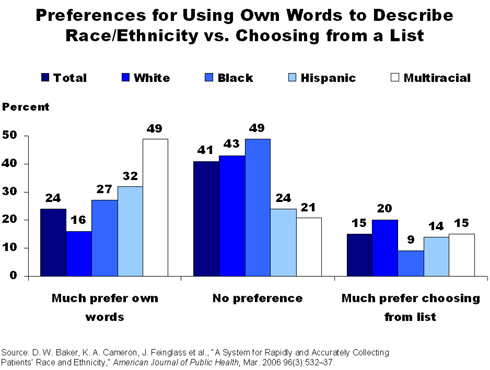In the Literature
A crucial first step to addressing disparities in the receipt and quality of health care is the routine collection of information on patients' race, ethnicity, and language, which can then be linked to measures of health care quality. Many providers, however, do not systematically collect this information, and more than half of those that do rely on registration desk clerks to record their personal impressions of patients' racial and ethnic backgrounds. The result is a hodgepodge of missing data and inaccurate classifications.
Allowing patients to describe their racial or ethnic background in their own words may improve the accuracy of such data while aiding efforts to eliminate disparities, a new Commonwealth Fund-supported study finds. In "A System for Rapidly and Accurately Collecting Patients' Race and Ethnicity" (American Journal of Public Health, Mar. 2006), David W. Baker, M.D., M.P.H., and colleagues report that when they tested such a system, participating patients were more receptive to answering questions, thereby improving the accuracy and utility of the data gathered.
Creating a Database of Racial and Ethnic Descriptors
Baker, who is based at the Northwestern University Feinberg School of Medicine, conducted the study in the General Internal Medicine clinic of Northwestern University. First, participating patients were asked to describe their race or ethnicity using any terms they wanted. These same patients were also asked questions based on standard categories issued by the federal Office of Management and Budget (OMB) and used by the U.S. Census Bureau (Latino, Hispanic, White, Black, African American, Asian, Native Hawaiian or Pacific Islander, American Indian or Alaska Native, multi-racial, or other) and then asked which method they preferred. Based on the terms the patients provided, the research team designed a computer program with the terms listed in a drop-down menu. In the second phase of the study, patients in a different group were asked to describe themselves in their own terms, while research assistants captured the information using the computer program. A total of 424 patients participated.
Using Patients' Own Terms Generates More Usable, Complete Data
Compared with the traditional OMB method, allowing patients to use their own words resulted in more complete and usable information, the study found. When patients had the capability to be specific, they were less likely to choose "other" as a descriptor to characterize their background or refuse to answer and be characterized as "unknown."
For instance, among the 37 patients who described themselves as Latino, Hispanic, or from a Central or South American country, 17 chose "other" as their race when asked to choose from a list. Similarly, of the six patients who identified themselves as Middle Eastern, two chose "other" and one refused to answer.
Nearly a quarter (24%) of those surveyed expressed a strong preference for using their own words, and an additional 8 percent somewhat preferred using their own words. Preferences varied among racial and ethnic groups. For example, while 35 percent of African Americans somewhat or strongly preferred to use their own words, 46 percent of Latinos/Hispanics and 52 percent of multiracial/multiethnic participants preferred this method—a possible reflection of the greater value they place on identifying themselves in precise terms.
The high level of agreement—93 percent—between the categories generated by patients' own descriptors and the categories based on the standard OMB questions suggests that health care providers could aggregate unique terms to correspond with the major OMB categories. This would allow providers to comply with federal or state reporting requirements.
In addition to yielding more accurate data, the new method proved to be efficient. Patients' verbatim responses were captured in an average time of 37 seconds—only 17 seconds longer than the mean time for completing the OMB questions. "[P]roviders should be reassured that collecting this level of detail does not pose major time or cost burden," the researchers say.
Conclusions
Allowing patients to use their own words appears to be a powerful tool for health care providers seeking to collect patients' race and ethnicity information both rapidly and accurately. Moreover, the high level of detail this method yields will allow providers to pinpoint vulnerable populations that should be targeted for quality-improvement efforts.
Facts and Figures
- A previous study found that 78 percent of U.S. hospitals systematically collected data on patients' race or ethnicity.
- In the initial study phase, when participants were asked to describe themselves with any terms they wanted, 46 percent used a single term, 33 percent used two terms, 14 percent used three terms, and 6 percent used four terms.
- Of individuals who described themselves with two or more terms or as multiracial, 55 percent chose a single race category, 27 percent chose "multiracial," and 18 percent chose "other" when asked to choose from a list.
